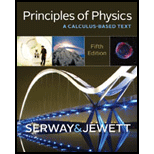
Concept explainers
(a)
The speed of the skateboarder at the bottom of the half pipe.
(a)
Answer to Problem 84P
The speed of the skateboarder at the bottom of the half pipe is
Explanation of Solution
The total energy of the system is conserved. Since the skateboarder is starting from rest the initial kinetic energy will be zero, and when he reaches at the bottom of the half pipe the potential energy will be zero. Thus the potential energy is being converted to kinetic energy.
Write the conservation equation for energy.
Here,
Substitute,
Here,
Rearrange to obtain an expression for
Conclusion
Substitute,
Therefore, the speed of the skateboarder at the bottom of the half pipe is
(b)
The
(b)
Answer to Problem 84P
The angular momentum about the center of curvature at the bottom of the half pipe is
Explanation of Solution
Write the expression for the angular momentum.
Here,
Conclusion:
Substitute,
Therefore, the angular momentum about the center of curvature at the bottom of the half pipe is
(c)
To explain why the angular momentum is a constant and kinetic energy changes when the skateboarder stand up and lift his arms after passing through the bottom point.
(c)
Answer to Problem 84P
Since there is no external torque, the angular momentum is conserved, but at the same time the chemical energy of the skateboarder is being converts to mechanical energy, hence the kinetic energy is not conserved.
Explanation of Solution
As the person stand up and lift his arms after passing through the bottom point there is no torque acting about the axis of the channel on him, and also the wheels of the skateboard prevent the tangential force acting on him. Since there is no torque and no external force the angular momentum will be kept conserved.
But as the person stand up and lift his arms after passing through the bottom point, his legs convert the chemical energy to mechanical energy required to moving forward. According to work energy theorem the work done by the skateboarder results in increasing of kinetic energy. Hence the energy of the system is not conserved.
Conclusion:
Therefore, since there is no external torque, the angular momentum is conserved, but at the same time the chemical energy of the skateboarder is being converts to mechanical energy, hence the kinetic energy is not conserved.
(d)
The speed of the skateboarder immediately after he stood up.
(d)
Answer to Problem 84P
The speed of the skateboarder immediately after he stood up is
Explanation of Solution
Consider equation (II) to obtain the answer.
Conclusion:
Substitute,
Therefore, the speed of the skateboarder immediately after he stood up is
(e)
The amount of chemical energy converted to mechanical energy.
(e)
Answer to Problem 84P
The amount of chemical energy converted to mechanical energy is
Explanation of Solution
From point B to C chemical energy is being converted to mechanical energy. the total energy in this case is also a constant.
Write the equation for the conservation of energy from point B to C.
Here,
Substitute,
Here,
Conclusion:
Substitute,
Therefore, the amount of chemical energy converted to mechanical energy is
Want to see more full solutions like this?
Chapter 10 Solutions
Principles of Physics: A Calculus-Based Text
- 8. With the aid of a diagram draw the following electric circuit and use the resistor as the load, (a) Closed circuit (b) Open circuitarrow_forwardLab 8 Part 3 PHET Wave Interface simulation. I am having trouble with this part of the lab.arrow_forwardMick and Rick are twins born on Earth in the year 2175. Rick grows up to be an Earth-bound robotics technician while Mick becomes an intergalactic astronaut. Mick leaves the Earth on his first space mission in the year 2200 and travels, according to his clock, for 10 years at a speed of 0.75c. Unfortunately, at this point in his journey, the structure of his ship undergoes mechanical breakdown and the ship explodes. How old is Rick when his brother dies?arrow_forward
 Principles of Physics: A Calculus-Based TextPhysicsISBN:9781133104261Author:Raymond A. Serway, John W. JewettPublisher:Cengage Learning
Principles of Physics: A Calculus-Based TextPhysicsISBN:9781133104261Author:Raymond A. Serway, John W. JewettPublisher:Cengage Learning Physics for Scientists and Engineers, Technology ...PhysicsISBN:9781305116399Author:Raymond A. Serway, John W. JewettPublisher:Cengage Learning
Physics for Scientists and Engineers, Technology ...PhysicsISBN:9781305116399Author:Raymond A. Serway, John W. JewettPublisher:Cengage Learning College PhysicsPhysicsISBN:9781285737027Author:Raymond A. Serway, Chris VuillePublisher:Cengage Learning
College PhysicsPhysicsISBN:9781285737027Author:Raymond A. Serway, Chris VuillePublisher:Cengage Learning Physics for Scientists and EngineersPhysicsISBN:9781337553278Author:Raymond A. Serway, John W. JewettPublisher:Cengage Learning
Physics for Scientists and EngineersPhysicsISBN:9781337553278Author:Raymond A. Serway, John W. JewettPublisher:Cengage Learning Physics for Scientists and Engineers with Modern ...PhysicsISBN:9781337553292Author:Raymond A. Serway, John W. JewettPublisher:Cengage Learning
Physics for Scientists and Engineers with Modern ...PhysicsISBN:9781337553292Author:Raymond A. Serway, John W. JewettPublisher:Cengage Learning University Physics Volume 1PhysicsISBN:9781938168277Author:William Moebs, Samuel J. Ling, Jeff SannyPublisher:OpenStax - Rice University
University Physics Volume 1PhysicsISBN:9781938168277Author:William Moebs, Samuel J. Ling, Jeff SannyPublisher:OpenStax - Rice University





